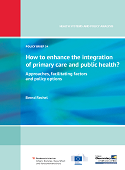How to enhance the integration of primary care and public health? Approaches, facilitating factors and policy options (2020)

Download
This policy brief explores how primary care and public health can be brought together to improve the health of patients and populations. It describes the types of initiatives that have been undertaken; provides examples of such initiatives in Europe and beyond; and summarizes the factors that can help to enhance or hinder the integration of primary care and public health.
The policy brief argues that there is a large overlap of activities between public health and primary care. In most European countries primary care performs some public health functions, while public health can help to make the provision of primary care more effective.
The policy brief identifies organizational models of primary care that are conducive to integration with public health and describes the key systemic, organizational and interactional factors that can facilitate integration between the two domains.
The brief’s key messages are:
- There are universal calls for improved integration between public health and primary care, but it is less clear how this can be achieved – and, in practice, integration is often hampered by the ways in which both sectors and services are organized and financed, as well as through other obstacles.
- Interaction between public health and primary care is complex. Some functions are more clearly situated in one of the two domains, while others belong to both of them. For example, primary care often performs some public health functions (e.g. screening, immunization and interventions to support healthy lifestyles), while public health helps to make the provision of primary care more effective (e.g. through surveillance, planning and evaluation).
- Enhanced integration between these two domains can bring health and other benefits (although these are not clearly documented in the literature), but can also bring risks, of which policy-makers should be mindful, such as placing an additional burden on already limited (financial, human and other) resources.
- Much of the recent academic literature on the integration of public health and primary care is from the United States, but there are also many examples from Europe. We cluster the examples into five categories, but these are not mutually exclusive, and many interventions (such as increased adoption of electronic patients records) could fall under more than one category:
- Coordinating health care services for individuals, e.g. by bringing clinical and public health professionals together at one site.
- Applying a population perspective to clinical practice, e.g. by using population-based information to enhance clinical decision-making.
- Identifying and addressing community health problems, e.g. by using clinical opportunities to identify and address underlying causes of health problems.
- Strengthening health promotion and disease prevention, e.g. through education, advocacy for health-related laws or regulations.
- Collaborating around policy, training and research, e.g. by engaging in cross-sectoral education and training, or conducting cross-sectoral research.
- There are organizational models of primary care that are conducive to integration with public health, as well as systemic, organizational and interpersonal factors that can facilitate integration and provide a useful checklist for integration attempts at either the national or regional level. Which model comes into consideration and which factors play a key role will depend very much on the specific country context and the organizational set-up of primary care and public health.
- Yet, a systematic approach to improved integration can be broadly guided by the following principles, which have been identified as essential to success: a shared goal of population health improvement; community engagement; aligned leadership; sustainability; and sharing and collaborative use of data and analysis.





















